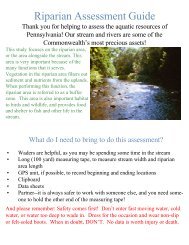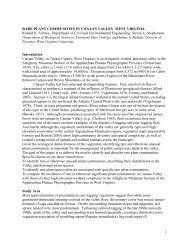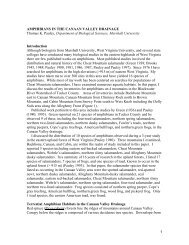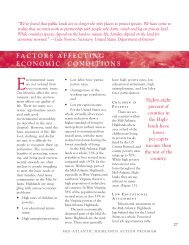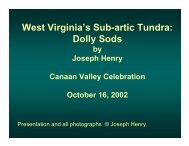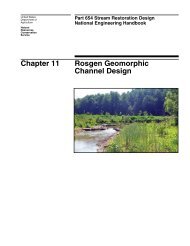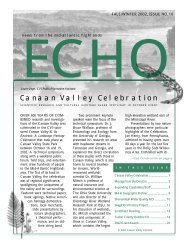1 PREHISTORY OF CANAAN VALLEY: AN ECOLOGICAL VIEW ...
1 PREHISTORY OF CANAAN VALLEY: AN ECOLOGICAL VIEW ...
1 PREHISTORY OF CANAAN VALLEY: AN ECOLOGICAL VIEW ...
Create successful ePaper yourself
Turn your PDF publications into a flip-book with our unique Google optimized e-Paper software.
How do we reconcile Native Americans' (a) respect for the environment,<br />
conservation ethic, and keen sense of interdependence; with their (b) depleting soils, over<br />
hunting game, and setting destructive fires? If we accept the proposition that the<br />
evolutionary processes of natural selection, and its extensions of sexual and kin selection,<br />
have functioned similarly in people of all times (Wilson 1975, Trivers 1985), then<br />
prehistoric and modern Canaan Valleyans have had the same basic needs, motives, and<br />
responses. In humanistic terms, we have been similarly contradicted–with differences<br />
among individuals within groups, and with inconsistencies within each of us expressed at<br />
different times. We have been hypocritical, short-sighted, and selfish; and also helpful,<br />
far-sighted, and altruistic. Perhaps they were no better or worse than the average person<br />
today.<br />
Acknowledgements<br />
I have been helped by many generous people. Lee Avery, Ruth Brinker, John Calabrese,<br />
Bob Hoffman, Hunter Lesser, David Matchen, Dewey Sanderson, and Tom Wynn shared<br />
scientific insights. Doug Wood helped to map the trails. Friends at CVI, including Kip<br />
Ambro, Beverli Badgley, Ryan Gaujot, Cindy Phillips, Ron Preston, Matt Sherald,<br />
Jocelyn Smith, Ron Wigal, Paula Worden, and especially Ellen Voss, helped in various<br />
ways. Leah Constantz, MAAR Associates, and Bob Maslowski provided literature.<br />
Nancy Ailes, Jim Rawson, and two anonymous reviewers criticized the manuscript.<br />
Thanks to all.<br />
References<br />
Adovasio, J.M., and J. Page. 2002. The first Americans: in pursuit of<br />
archaeology’s greatest mystery. Modern Library, New York NY. 330 p.<br />
Adovasio, J.M., J. Donahue, and R. Struckenrath. 1990. The Meadowcroft Rockshelter<br />
radiocarbon chronology 1975-1990. American Antiquity 55: 348-354.<br />
Alcock, J. 1984. Animal behavior: an evolutionary approach, third edition. Sinauer<br />
Associates, Inc., Sunderland, MA. 596 p<br />
Botkin, D.B. 1995. Our natural history: the lessons of Lewis and Clark. G.P. Putnam's<br />
Sons, New York, NY. 300 p.<br />
Brashler, J.G. 1984. Exploitation of diffuse resources: Archaic settlement in<br />
mountainous West Virginia. In: Geier, C.R., M.B. Barber, and G.A. Tolley<br />
(eds.), Upland Archeology in the East, Symposium Number 2. USDA Forest<br />
Service-Southern Region and Archeological Society of Virginia, Special<br />
Publication Number 38-Part 2: 5-24.<br />
Brashler, J.G., and W.H. Lesser. 1985. The Limekiln Run site and the reduction of<br />
Greenbrier chert in Randolph County, West Virginia. West Virginia<br />
Archeologist 37 (1): 27-40.<br />
13





